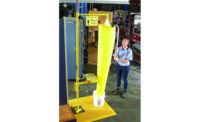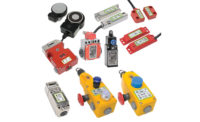Most safety managers are familiar with the basic requirements for primary emergency eyewash stations. The American National Standards Institute (ANSI) Z358.1 calls for primary stations to be located within a 10-second unobstructed path of the chemical and capable of delivering a 15-minute flush to both eyes with tepid fluid.
When injury to the eyes occurs, every second counts. Flushing the eyes immediately is the single most effective way to remove harmful substances and ensure the best possible outcome. If treatment is delayed — even by seconds — the effects can escalate from a temporary condition to permanent blindness.
Despite national safety standards, mounting primary stations in confined, remote or electrified locations poses inherent challenges. As a result, noncompliance remains high: It is estimated that only 50 percent of U.S. workplaces meet eyewash requirements.
The good news is, when safety managers choose the proper type of eyewash delivery system, even in challenging locations, they can significantly improve outcomes and reduce the hefty costs associated with workplace eye injuries.
Personal bottles might not be enough
Some environments are exempt from ANSI’s requirement for primary eyewash stations because such stations are too large, too heavy or impractical to install. In some confined spaces or vehicle fleets, for instance, personal eyewash bottles are an acceptable solution to making eyewash available. These small, portable bottles contain saline and are considered to be suitable for flushing the eyes in the case of contact with nuisance particles such as pollen, dust, sawdust or smoke.
However, personal bottles have limited capacity and flush only one eye at a time. For these reasons, personal bottles do not meet ANSI standards for treating eyes that have come in contact with harmful chemicals or caustics.
When it comes to locations where installing a primary station is impossible, or where the chance for exposure to chemicals is slight, it is good practice to have personal bottles available or to install secondary devices. Yet, many safety managers are not aware of the high value and added convenience secondary eyewash devices deliver. This article looks at secondary eyewash best practices and solutions to help safety managers provide the safest options for treating injured eyes wherever primary eyewash is not viable.
Secondary eyewash devices
Secondary eyewash devices are capable of delivering one gallon or more of fluid to both eyes at the same time. Because of their smaller size, lighter weight and increased portability over primary stations, secondary stations can be located in many challenging work spaces unsuited for primary stations. Therefore, secondary stations are ideal for industries with confined spaces, vehicle fleets or field locations, such as construction, utilities, chemical transportation, agriculture, airlines and airfield operations, oil fields and more.
Confined spaces
Take a confined space such as a janitorial closet, for example. Typically stocked with a variety of harsh cleaning agents containing corrosive chemicals, these work spaces may also contain concentrated chemical solutions that require mixing prior to use, as well as liquids that are flammable or combustible. Such hazards pose significant risks to the eyes through chemical splash, spills and harmful vapors. Yet, despite the hazards present, size constraints usually do not allow for a primary station to be mounted here. A secondary device, which is much smaller and lighter, is an ideal solution.
Battery-charging stations
Battery-charging stations are another area where secondary eyewash stations may be an ideal fit. Busy hubs for small- and mid-sized industrial vehicles, these locations contain a variety of hazards brought on by the lead-acid or nickel-iron batteries charged there. The oxygen and hydrogen gases emitted during charging can be highly volatile and, in the case of overcharging, concentrations can become explosive. In addition, corrosive chemicals exist within the batteries, such as sulfuric acid, which can leak or spill.
Forklift operators or other individuals responsible for charging battery-powered vehicles are often not protected properly from these hazards, and eyewash stations are commonly missing as well. Exposure to a leak, spill or explosion can result in permanent vision loss to the employee and significant expense to the company. Given these risks, where a primary eyewash station cannot be installed within the area of a battery charging station, a secondary station may be a good option.
Field locations
Field locations such as those in construction, off-site storage, pumping stations, utility hubs and chemical carriers are other common places where eyewash noncompliance is high. The reasons range from simple oversight to infrequent visits, lack of plumbing or an unwillingness to invest in multiple primary eyewash stations for multiple remote locations.
In areas where the potential risk of employee exposure to chemicals is low or visits to the site are infrequent, the site may be evaluated for the installation of a secondary station rather than a primary one. If field locations are under your purview, consider secondary stations for a highly portable and affordable solution that will keep your company in compliance.
Electrified environments
Some secondary stations are an appropriate solution to providing eyewash in electrified environments. Since water conducts electricity, it is generally not safe to have any fluids near electrified equipment or components. Yet hazards to the eyes often exist in such work areas, and eyewash should not be overlooked as an essential first aid resource here. In environments with electrical current or those where water poses a risk to equipment, look for a secondary unit that is self-contained. Such units feature a reservoir into which wastewater is captured and contained until it can be properly and safely disposed of, eliminating the risk of spills, shock and electrocution.
Ensuring the availability of emergency eyewash is crucial to protecting your workforce and supporting productivity. Given the various benefits secondary stations deliver, they are well suited for a wide range of applications. Once a thorough hazard assessment has been conducted, you may find that secondary eyewash stations are an ideal way to make eyewash available in places where primary eyewash is too difficult to fit or mount. With a solid understanding of eyewash requirements and careful planning, you can actively support your company’s vision for a successful culture of safety.



